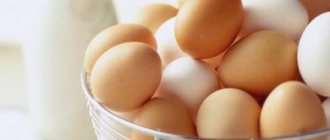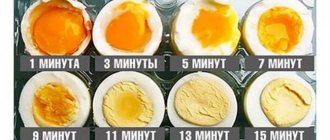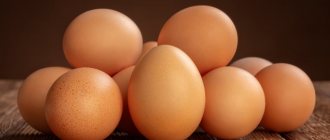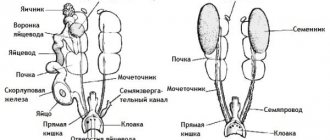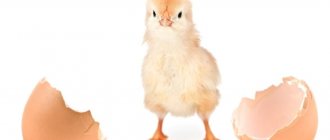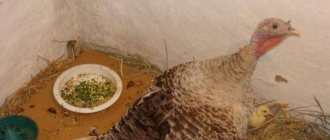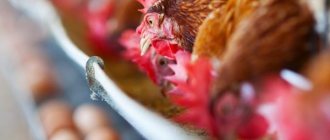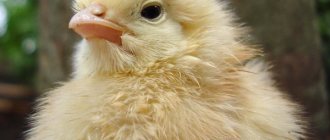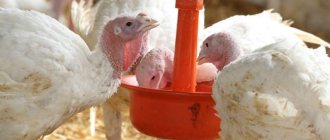When you go shopping in a supermarket, on the shelves with eggs you can find different categories, which differ in price. How are these eggs different? How are they divided into categories and which category of chicken eggs is better? Questions that every buyer will answer. Let's try to understand this topic.
Product containing “sun” (vitamin “D”)
Egg weight by category: table
Further in the text there is information about how much an egg of category 1, category 2, etc. weighs. The given weight is for one unit.
| Category | Weight with shell, g | Weight without shell, g |
| Third | 35-44,9 | 32-40 |
| Second | 45-54,9 | 40-50 |
| First | 55-64,9 | 50-59 |
| Selective | 65-74,9 | 59-68 |
| Higher | From 75 | From 68 |
In GOST, such a table is wider; it is supplemented with information about the weight of a dozen and a package of 360 pcs. products.
Signs of quality eggs
High-quality chicken treasures should be clean (no feathers or droppings), no cracks, and consistent in size and weight. Each egg must have a stamp and marking on it. This allows you to find out the category of eggs and their maximum shelf life.
The shell of a fresh egg should have a matte, not glossy color. If you place a fresh egg to your ear and shake it, you should not hear any sounds (gurgling). If the egg is too light, this may mean that it has already dried out and may be rotten.
What are the types and categories of eggs?
Categories of eggs
Egg products are divided into two large groups (types of eggs):
- Dietary , designated by the letter “D” in red. According to established standards, they have a shelf life of up to 7 days. The shell must be clean, only small specks are allowed. Storage temperature - not lower than 0. The white is dense, the yolk is evenly colored.
- Dining rooms that are about blue. Products with this marking can be stored at room temperature for up to 25 days, in refrigerators for up to 90 days. Their yolk is mobile, the white has a low density.
Based on weight, testicles are divided into 5 categories:
Types of incubators
Incubators are electrical devices that are used to hatch chicks.
There are household (simultaneous use of 10÷250 pcs.), for farms (250÷2500 pcs.) and industrial (from 2500 pcs.).
Hand incubators
Hand incubators are used by rural residents to hatch chicks for themselves. Small capacity up to 250 pcs. Manual temperature adjustment. The eggs are also turned by hand to ensure even heating.
Automatic incubators
Divided into types:
- Rolls automatically. They use tray movement.
- Turning masonry over by rotating on rollers.
- The tilt of the trays is no more than 450.
- With a thermostat: analog, which maintains the set temperature regime, and digital, which automatically regulates the temperature, changes the humidity in the incubator, and gives the command to turn the trays.
What is the difference between dietary, table and small chicken eggs?
Chicken eggs should be sorted into dietary, table and small . Dietary include eggs that have a clean and strong shell, a fixed egg no larger than 4 mm in size, a strong, barely noticeable yolk that occupies a central position in the egg and an invisible germinal disc. The mass of such eggs must be at least 58 g (1st category) or at least 44 g (2nd category). Table eggs are also divided into 2 categories: the 1st includes eggs with a clean, strong and whole shell, a fixed air chamber. The yolk of such eggs is strong, inconspicuous, occupying a central position in the egg, the white is dense, translucent, the height of the puga is not more than 11 mm, the weight of one egg is not less than 47 g; Category 2 includes eggs with a clean, strong and whole shell, slight contamination in the form of individual dots is allowed, the shell moves easily and can have a height of up to 13 mm, the yolk is weakened, clearly visible when the egg is scanned, the weight of one egg is not less than 43 g Chicken eggs that have all the indicators of good quality, but weighing less than 43 g, are defined as small .
Dietary eggs are stored at temperatures from 0 to 20 °C - 7 days; dining rooms - at a temperature not higher than 20 ° C - 25 days, at a temperature from 0 to 2 ° C - no more than 120 days. If the shell is contaminated, the shelf life of eggs is significantly reduced.
The best domestic incubators
Incubator “Cinderella” IN 45/220V with manual rotation
Capacity – 45 pcs. Power – 50W. Maintaining the required temperature with an error of 0.20C. Manual turning for even heating. The instruction manual supplied with the product should be strictly followed to produce healthy, strong chicks.
Price: about 2000 rub.
“Cinderella” IN 45/220V - an economical option for hatching chickens
Incubator for eggs "Laying hen" for 104 pcs., automatic
Fully automatic control allows you to automatically control the temperature and control the humidity value, thanks to the presence of an ultrasonic sensor.
If the power suddenly goes out, it switches to a backup power supply of 12 V, and when connected, it returns to the main one.
Turns over automatically after a set period of time. If there is a problem with operation, the red lamp on the control unit lights up.
2 fans inside the incubator ensure uniform heating. In addition to the product, you can order cells for goose, duck, or increase the number of chicken.
The manufacturer provides warranty service for 24 months.
Price: 7300 rub.
"Laying hen" operates in automatic mode
Incubator “Cinderella” IN 98/220V with automatic rotation
Capacity – 98 pcs. Power – 75W. The incubator is equipped with an automatic revolution of all eggs placed in it. Additionally, the kit includes 2 grilles. The operating instructions supplied with the product by the manufacturer must be strictly followed.
Price: about 4000 rub.
Fully automatic incubator
Other designations
Additional symbols are designed to attract the attention of the consumer.
The trend to choose healthy foods is driven by the fashion for a healthy lifestyle. Today, manufacturers adjust ordinary products to fit it, using tricks that are invisible to the gullible buyer.
Village products in the store
Supermarkets work only with large suppliers who are able to pay decently for advantageous shelf space and provide the required volumes of products.
The attractive name “Village”, accompanied by a picture of chickens peacefully walking on a green field, is purely a marketing ploy.
Environmental friendliness
Eco-labeling is only possible for products whose production meets strict international and national requirements.
The oldest signs on the market indicate an increased level of product safety for the environment, but not all of them are used for food products.
These include:
- "Ecosign", European Union;
- "Blue Angel", Germany;
- "Environmental Choice", Canada;
- "White Swan", Scandinavian countries;
- "Eco-sign", Japan.
There is no unified eco-labeling system in Russia. Analogues of European variations are the icons: “Eco”; "Bio" The legality of their use in most cases remains on the conscience of the manufacturer.
In theory, such labeling should mean that the product is produced without the use of pesticides, hormones, fertilizers and growth stimulants.
The use of GMOs and any veterinary drugs, including antibiotics and vitamins, is also excluded.
Raising poultry to obtain such an egg is required in regions that are not exposed to high doses of radiation and free from other contamination.
The prefix “bio” means that laying hens should roam freely around the pasture without lack of natural feed.
A dozen eggs obtained under such conditions cost disproportionately more than usual. Whether to trust labels for similar products sold at average prices is an open question.
Foreign incubators
Automatic incubator Sititek-112
The incubator has a built-in thermostat, automatic turning 112 pcs.
The main power supply is 220V, there is a built-in 12V battery (in case of a power outage).
The thermostat maintains the desired temperature range with an error of 0.10C. The hygrometer continuously monitors humidity levels.
The stand provides a stable position for the eggs placed on it. There is a special recess for evaporating water.
The product kit includes an ovoscope, which determines the condition of the eggs without removing them from the incubator.
Price: 10500 rub.
Sititek-112 – will allow you to hatch healthy chicks
Incubator HHD-32 with LCD display, LED backlight
Capacity – 32 pcs. Automatically maintains the desired temperature and turns trays at a set interval.
Equipped with a transparent lid that allows you to observe the hatching process. The ventilation system evenly distributes the heat flow between the cells. If the parameters deviate from the specified ones, the device will notify you with a sound signal.
Price: 5600 rub.
The transparent cover of the HHD-32 allows you to observe the removal
Chemical composition and beneficial properties of the product
The egg contains vitamins, microelements, amino acids, and other beneficial substances. The yolk has the most valuable supply of nutrients, because its purpose is to provide the embryo with everything necessary for development.
The egg contains vitamins, microelements, amino acids, and other beneficial substances
Structure of a chicken egg:
- Yolk. Occupies approximately 1/3 of the total volume of the testicle. It can be of different shades - from yellow to orange, the color does not affect the chemical composition.
- Protein . Liquid occupying 2/3 of the volume of the testicle. It is transparent and heterogeneous. Here is a cord, resembling an umbilical cord, that holds the yolk in the center.
- Air chamber. It is located on the blunt side of the egg, between the shells. When the product is fresh, its volume is minimal; during storage it gradually increases.
- Shell. It comes in different colors (white or cream), and there are breeds of chickens that lay eggs with brown, greenish, and bluish shells. It has tiny pores that provide air exchange with the internal contents of the testicle.
What do C0 and C1 have in common?
Eggs of these categories have a lot in common:
- Shell color. It can be white, cream, dark beige or yellowish. The quality of the product has nothing to do with the color of the shell, as some people think.
- Calorie content. This indicator depends primarily on the quality of nutrition of the chicken itself, but on average for all categories it is 155-157 kcal per 100 grams.
- Contents of the BJU. Everything is standard here too. The largest share is occupied by protein (12.7 g), followed by fats - 10.8 g and carbohydrates - 0.7 g (per 100 g).
- Marking color. The marking of all categories of the table group is blue, the dietary category is red.
It is also worth noting the similarity of the chemical composition. All eggs contain iron, zinc, selenium, phosphorus, sodium and potassium. Of the organic acids, the most valuable are Omega-3 and Omega-6, as well as B vitamins, retinol, tocopherol and phylloquinone. The chemical composition can be corrected through the nutrition of chickens, by introducing special additives into their diet.
Shelf life of chicken eggs: raw, boiled and in the refrigerator
Eggs in their shells should not be placed in the freezer.
The storage duration is influenced by the following factors:
- Origin of the product. Poultry farm products are stamped with a date - the shelf life is calculated from it (no more than a month). Eggs from domestic hens, if you are confident in their quality and in suitable conditions, can be stored for up to 3 months.
- Storage conditions . Temperature, air humidity, and other factors (absorption of foreign odors) influence. These products last the longest in the refrigerator.
- Shell integrity. Raw eggs with intact shells last longer. In the refrigerator - a month, at room temperature - up to 20 days from the production date, with a cracked shell - up to 2 days.
- Cooking method . Boiled eggs are stored much shorter and only in the refrigerator. Hard-boiled - no more than 14 days, soft-boiled - up to 2 days, cracked hard-boiled - up to 4 days, peeled hard-boiled - up to 3 days.
Attention! Eggs in their shells cannot be placed in the freezer; only the separated yolks are stored this way.
How to protect yourself from salmonella
Not only do we love eggs, but also the causative agent of a serious infectious disease - the salmonella bacterium. Protecting yourself from this uninvited guest is not so difficult.
- Dirt and dried droppings on the shell are not a sign of an “organic” egg; rather, they indicate insufficient hygiene in the poultry farm.
- Eggs with damaged shells should not be eaten.
- Before use, the egg should be washed under running water and soap. Remember to wash your hands, even if you just touched the egg.
- Store eggs in a cool, but not too dry place, away from strong-smelling foods and raw meat; the best temperature is 0–5 °C.
- Eggs can be pasteurized. To pasteurize, they are washed and then separated into sterilized containers. After combining the yolks with the whites, they are filtered and heated to +63 ° C for one minute, then quickly cooled.
Requirements according to GOST
According to the current GOST in the country, all categories of eggs produced by poultry farms for sale must meet the following requirements:
- whole, clean shell without inclusions;
- without foreign inclusions in the light;
- without smell;
- no moisture on the surface;
- on the ovoscope: the air chamber is motionless, the white is dense, transparent, the yolk is strong, barely noticeable, without a clear boundary, slightly mobile;
- have the marking and correspond to it;
- if processing was carried out, there must be an appropriate mark (1 - without treatment, 2 - chilled (stored at -20...0 °C), 3 - chilled (stored at 0-5 °C), 4 - processed for the purpose of preservation);
- lumpy materials that comply with regulatory documents are used as packaging (safe, intact, dry, odorless);
- one package must contain eggs of the same type and the same production date;
- the labeling on the packaging must correspond to the packaged product;
- containers that have already been used must be disinfected in accordance with regulations.
Which eggs to choose
- Table eggs of any size do not differ in nutritional value or nutrient content.
- The dietary, freshest options have an advantage.
- You can choose the type of product at your discretion.
Contrary to popular belief, the color of the shell does not affect the quality of the product.
- Poultry farms use productive crosses of egg-laying chickens. Some of them carry embryos with a brown shell, others with a white shell.
- There are breeds that produce embryos with bluish or green shells. Some of them are indeed more useful, but not because of color, but as a result of physiology.
Composition of eggs
Such birds, for example, ukheiliyu, cannot “boast” of high productivity.
The eggs of Chinese silk chickens have a cream-colored shell and also have a high content of:
- vitamins;
- microelements;
- other beneficial nutrients.
What to do if there is no marking on the shell
The absence of marks on the shell or a special label on the packaging is not permitted by law.
- Eggs without markings or packaging features can only be sold in markets.
- Private farmsteads and farms must have a certificate from a veterinarian confirming the health of the bird and the safety of the product.
How to distinguish a real country egg from a fake
The ability to buy good eggs is usually determined by the presence of trusted farms nearby. Their replacement with a cheaper product from the store can be detected based on the following signs:
- same size - domestic eggs are always heterogeneous in shape and volume;
- yolk color - rich yellow or orange in summer, becomes whitish in winter;
- The shell has a special difference - increased “roughness”, noticeable to an unprepared consumer.
The shelf life of such eggs remains normal, determined by the Technical Specifications. It is also necessary to pay attention to the contamination of the shell relative to its surface area.
If there is contamination in excess of 50% of the surface, wash the eggs with laundry soap under running warm water, or using special means.
In this case, the shelf life of the product drops to 12 days.
What to do if there is no marking on the shell?
The situation when the buyer did not find stamps on the product indicating “highest category eggs”, “select”, or others is rare. As a rule, when accepting goods, the store complies with the requirements for the presence of labeling. If there is no stamp on the product itself, you should look for the label on the packaging.
It is allowed that a mark about the type of product is not placed on it if there is a label on the packaging (and this label cannot be opened without spoiling it).
How to Determine the Freshness of Eggs by Dipping Them in Water
One of the most accessible is placing the eggs in a container with cool water:
- the fresh one will lie flat on its side on the bottom;
- when it is a week old, the blunt end will be slightly raised;
- in a perpendicular position at the very bottom - a period of 2 weeks;
- upon surfacing, it is rotten.
Important! If the white of a boiled egg has a grayish or bluish tint, then it should be thrown away. It is unsafe for humans to consume such a product.
